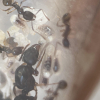I've been wondering what reasons there are for wanting a parasitic Lasius colony, besides the fact that they are relatively difficult to start up. Are their workers more yellow than Lasius flavus workers? I know they have a citronella smell to them but that doesn't seem like a good reason to keep them. Are their workers larger than Lasius flavus workers? I don't really know since I've only ever seen Lasius umbratus workers in person once and have never seen flavus workers, so I can't really draw a comparison. Also, do they grow faster than other Lasius? I feel like I've heard that before but would appreciate confirmation. Thanks!
- Formiculture.com
- Forums
- Gallery
- Members
- Member Map
- Chat



















